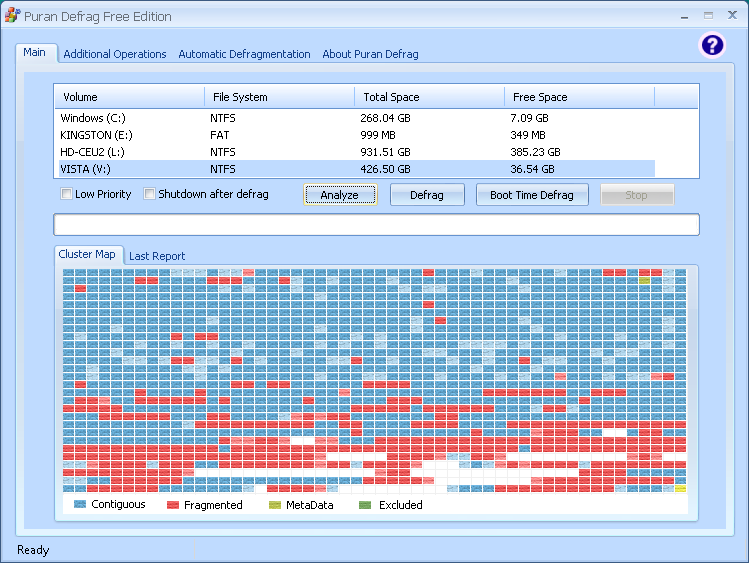-
Free Defragmenter Vista 64
Disk defrag your Windows with Smart Defrag freeware, Your first choice for defragging windows 10, 8, 7, XP and Vista. Download Free disk defragmenter now!



TweakNow RegCleaner is the fastest and the most reliable registry cleaner program available today.

Disk defrag your Windows with Smart Defrag freeware, Your first choice for defragging windows 10, 8, 7, XP and Vista. Download Free disk defragmenter now!


/about/mydefrag-free-defrag-software-56a6f9493df78cf7729136c4.png)

/about/ultradefrag-7-57c764723df78c71b650192c.png)
- UltraDefrag is an open source disk defragmenter for Windows. It can quickly defragment everything including files which are usually locked by Windows.
- In our 2015 review of the top free disk de-fragmenter, we found 5 we could recommend with the best of these as good as any commercial product.
- Puran Defrag Filename: PuranDefragSetup.exe File Size: 3.33 MB Home About Us Privacy Policy Terms of Use Uninstall Steps Copyright (C) 2007-2013, Puran Software.
- How to defrag your Windows XP/Vista/7/8? Anvi Ultimate Defrag is your best choice. One click to finish quick fix, clean up, disk defragmentation and optimization, it.

Disk Defragmenter in Windows 1. Starting with Windows Vista, the built- in Windows Disk Defragmenter has been much improved upon, and more so in Windows 8 and Windows 7, and is considered to be much better than its predecessor Windows XP.
The defrag engine and the manageability of fragmentation have been improved. The Disk Defragmenter runs as a low priority task in the background without affecting the performance of the computer. It runs only when the machine is idle! It uses the Task Scheduler to automatically keep the hard disk defragmented. This automated defragmentation does not affect the performance of the Windows. Now, by default, the defrag tool only defragments files smaller than 6. MB, for according to Microsoft’s benchmarks, fragments of this size, which already consist of at least 1.
This means that games and large media files are effectively left as they are! So if you still want to defrag files larger than 6. MB too, you need to use the - w parameter mentioned below to defragment files of all size. Starting with Windows 7, defragmentation became even more comprehensive – many files that could not be re- located in Windows Vista or earlier versions can now be optimally replaced. In particular, a lot of work was done to make various NTFS metadata files movable. This ability to relocate NTFS metadata files also benefits volume shrink, since it enables the system to pack all files and file system metadata more closely and free up space “at the end” which can be reclaimed if required. In Windows 7, Microsoft had turned off defragmentation for Solid State Disks.
In Windows 8 however, since the tool has undergone a change into a general disk optimization tool, you will see it enabled by default for SSDs too. You can read more about the Improved Disk Defragmenter and Storage Optimizer in Windows 8.
If you use a Solid State Drive, you may want to read this post on Defragmentation and SSD in Windows 8. The Disk Defragmenter process starts according to a schedule that you can adjust. You can open the Disk Defragmenter in Windows 8 or Windows 7, by right- clicking on a Drive’s icon, selecting Properties and clicking on the Tools tab. Here, you can change settings by clicking on the Change settings button and opt to run scheduled scans on a daily, weekly or monthly basis. It is best to run Disk Cleaner first and then empty the Recycle Bin before defragmenting. Disk Defragmenter will also not defragment files which are in use.
Best to try and shut down as many processes as possible and then defragment. Disk Defragmenter does not defragment the following files: Bootsect DOS, Safeboot fs, Safeboot CSV, Safeboot RSV, Hiberfil sys, Memory dump and the Windows page file.
However using the - b parameter, as mentioned below, will optimize the boot files. Disk defragmenter Command line options. There are various command line options for you to exercise control over the defragmentation process.
To defrag a specific drive, say Drive C, open a command prompt and type: defrag c: You can use the following parameters or switches with the Defrag command to further fine- tune your control: -r This is the default setting and defragments file fragments that less than 6. MB.- a Analyze the selected drive / volume & display a summary report, consisting of analysis and defragmentation reports.- c Defragments all volumes on the computer. Don’t specify a drive letter while using this.- w Perform FULL defragmentation of files of ALL sizes.- f Forced defragmentation even when there is less amount of free space on the drive being defragmented. A volume must have at least 1. Disk Defragmenter can completely defragment it.- i This makes Defrag run in the background & operate only if the computer is idle, like when running as a scheduled task.- v Displays complete reports.- b It optimizes boot files and applications only.
The only indication you will get is a blinking cursor. This means that the process is going.
To interrupt the defragmentation process, press Ctrl + C in the command window. You can read more here on Defrag Options & Command line switches. Disk defragmenter does not run. If you find that you are unable to defragment or cannot run the defragment utility in Windows or that a drive or volume has been marked as having errors, run chdsk by enteringchkdsk c: /fat any command prompt; where c is the drive letter.
You will be able to then run Defrag after Chkdsk has repaired the file system. If you still face problems, see this post on Disk defragmenter could not start or Failed to initialize. In Windows 1. 0/8, while the default defragger is good enough for most of us, there are some who prefer to use Free Defragmentation Software. You may want to have a look at these too. Do you know about the Hidden Partitions displayed in Disk Defragmenter Tool?
-
Commentaires
